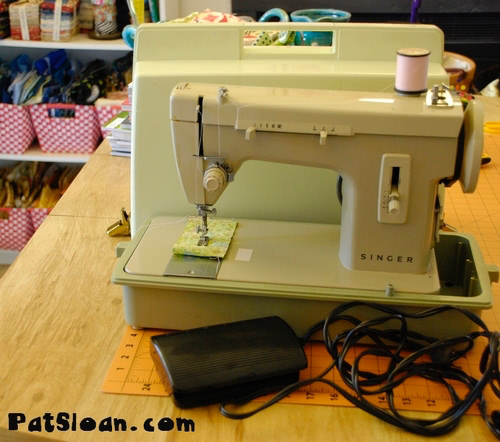
My first sewing machine belonged to my mom (which she didn’t use much), was in a cabinet and instead of a foot pedal we used a knee lever to ‘drive’… oh those were the days! I then was given a ‘Genie’ (see Roseann’s below) that was in European Currency. So when I went to college my mom said I ‘needed’ a machine and bought me this minty number above!
I’ve bought several machines since. And I’ve had many brands on loan…. Berninas, Vikings and Janomes. They are all great machines and all have some personality that you need to bond with.
I asked three friends to write about looking for a machine. Roseann has been sewing a long time and in addition to being a designer, she owns a store. So she has the chance to see a LOT of machines and talk to a lot of people about them.
Then I asked Rachel to share her experience of looking for a new machine. She just went through the process so it’s great to have a buyer’s perspective.
Then Leah tells us the options she looks for in a machine that you want to do free motion quilting on.
Roseann Kermes – “What to look for in a sewing machine”
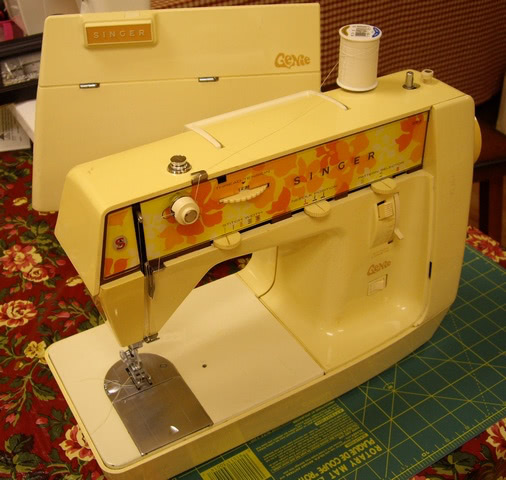
Here’s the link to a blog post about my Genie sewing machine … many of the same things I looked for at 19 apply to me now.
When I shop for a machine, these are the items that I feel are important for the kind of sewing I do.
- Affordable
- A bobbin that loads from the top as I find it easier to load and I can see how much thread is left
- I want the bobbin thread to fall in line, exactly in line, with the previous stitch and not to come in at a slight angle. I do a lot of work where I need a nice, clean line, such as on a doll body, and if the bobbin thread comes in at an angle it makes it difficult to have a perfect curve.
- A bobbin that’s easy to wind and winds full
- Good built-in lighting
- Wider and higher stitching area for when I’m working on bulky projects
- Needle-down function for chain piecing or pivoting
- Minimum of stitches that do basic functions – straight stitch, zigzag, blanket stitch
- 1/4″ quilter’s foot for piecing
- Walking foot – either built in that doesn’t require a lot of work to engage, or one that attaches
- A good fitting table if it’s not going into a cabinet
- Portable to some extent
- Controls that are easy to use and at my fingertips
- Back tack
- Start and stop button on the face of the machine
- Speed control
- Stitch adjustment
- It has to feel ‘good’ when I test drive it
- Has a good sound
- Nice stitch quality
- Not so many bells and whistles that I’ll never get use from
- Follow-up from the dealer for periodic tune ups and classes on how to use it
- Good repair and technical record for the machine brand
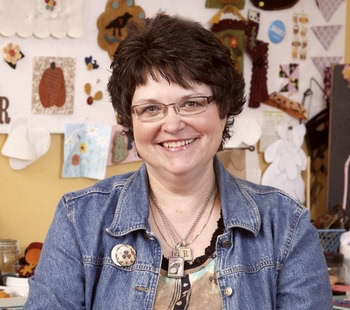
I have three Janome machines … one is a Jem that I use for retreats because it’s lightweight and sews well, a larger quilting edition that we use in the store and is a work horse, and a Memory Craft 6600 that I use in my workroom for my own use. I’d like to move up to a bigger machine that has an easier to use walking foot system but can’t justify the added expense.
I have a Featherweight that is so pretty but I’ve never gotten the hang of putting in the bobbin correctly or maintaining it.
I tell customers who are asking for help deciding to think about the kind of sewing they like to do, to buy what they can afford, to sit down and test drive all the machines out there until they find one that feels right to them, to ask their friends what they think of the sewing center they are thinking of purchasing from. You don’t need an expensive machine to be a good quilter … you need a reliable machine that sews well.
Roseann Meehan Kermes
Rosebud’s Cottage | Blog | Facebook
Rachel on Shopping for a New Machine
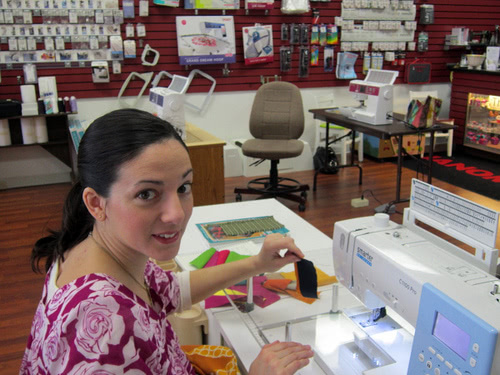
Shopping for a new sewing machine is such a high stakes game. For many it’s a decision you’ll have to live with for years to come, and one that can seriously affect your favorite hobby or even your livelihood. Hmm… maybe that’s why I put off shopping for so long. Oh, the pressure! But I’m facing the challenge lately with the help of my readers, who have offered so much excellent advice! There’s a lot to be said on the subject, but let’s see if I can cook it down to the Top 5 Things I’ve Learned along the way:
Top Thing #1: Know what YOU want. Choosing a sewing machine is a very personal decision because your needs and preferences are unique. Consider what you love about your current machine that you won’t want to do without. Before getting wowed by all the fancy features out there that you didn’t even know existed, make a list of what features you really want today. These are the important ones! Once you have that base, start gathering information about other features that your friends love or you come across in your research. Much of the time you won’t know which fancy features are really important until you try them in person. More on that later!
Other Top Thing: Get to know your options. Ask friends who do the same type of sewing as you what machine or brand they’ve been most happy with. This is where the research really needs to happen. Start with the brands. Are you interested in Janome, Pfaff, Bernina, etc.? Realize that many brands buy out other brands but keep making them under the already established label. For example, Janome makes Elna and Pfaff makes Viking. Visit the web sites of the brands on your radar to make a list of models that meet your needs. Unfortunately, manufacturers don’t list prices on their web sites, so once you have models you need to contact local dealers to get quotes. Some prices can be found in online with sewing machine retailers. Prices on Ebay are not comparable to dealers’ prices, so keep that in mind.
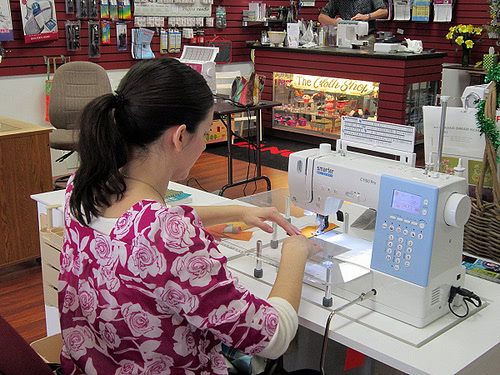
Top Thing #3: Consider Used. So, there you are making a list of models of interest. As you discover prices, don’t write off machines that are out of your price point right away! Many dealers sell used machines that have come into the store when their customers traded up to a different machine. If you buy used, you can get more for your money. Besides dealers, you can also find used machines locally through Craigslist or online through Ebay. In fact, many machines are being sold new in box on Ebay for awesome prices. Still, think of buying on Ebay as buying “used”. In this case, you really don’t know how the machine has been treated and no one is going to back it up if it fails right away. Warranty’s are typically void if a new machine is purchased through Ebay. In contrast, if you buy used from a dealer, that dealer will often stand behind the machine with service and a warranty.
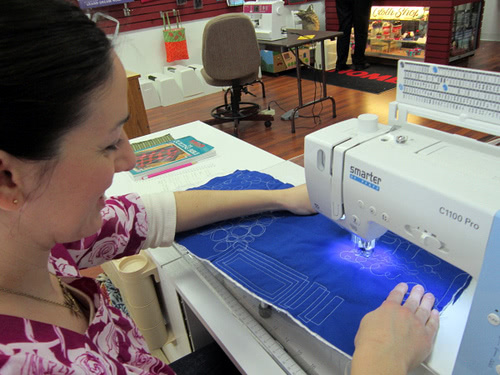
Very Important Top Thing: Watch out for Lemons! If you begin to poll your friends about machine X, you’re going to get a mix of responses – usually both glowing endorsements and awful reports. Why is this? I have heard conflicting reports from people I respect all too often to attribute the situation to user error. It is my belief that just as with cars, there are “lemons” among the world of sewing machines. Due to quality control issues or maybe being dropped one-too-many times, many well-designed sewing machines turn out to be defective. The best way to protect yourself from getting a lemon is to sew on the actual machine you are buying before taking it home. Bring your typical projects and test out all of the features that really matter to you. This happens best at the store…
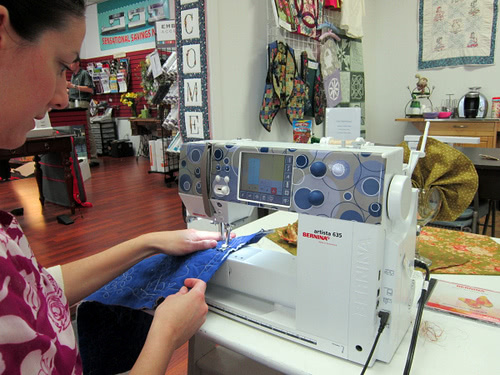
Most Tippity Top Thing: Test drive and bargain. Really, there’s no better way to move forward after you’ve done some research than to step into the store of your local dealer. Or, even visit all of them! If at all possible, sew on every machine on your interest list. While there, keep an eye out for used machines! By test driving machines you can confidently sort out what fancy features you’ll use and what ones just don’t matter. You can make real decisions about the quality of a machine by how it sews on your typical projects. Bring lots of samples to sew and give yourself time to absolutely concentrate. Heck, I took notes! And also… don’t plan to buy when you test drive. Your dealer will see that you are serious and will likely make you some offers. This is a good time to bargain! Write down his best offer and ask for it next time, when you’re ready to buy. And don’t forget to ask for a few presser feet and other extras to be thrown in while you’re at it!
I hope these tips will help you navigate the intimidating journey that is sewing machine shopping. For more specifics about my own search, please visit me at Stitched in Color where I received so many responses to my SOS Sewing Machines plea for help and shared my experience test driving machines at How to Buy a Sewing Machine.
Rachel
Stitched in Color
MAKE. handmade. do. Good.
What to Look for in a Home Sewing Machine for Free Motion Quilting

Picking a machine specifically for free motion quilting can be a frustrating task. For one thing, it’s very hard to know if a machine will be good at free motion quilting because there really isn’t a setting, specification, or even a feature to look for when shopping for a machine for this reason.
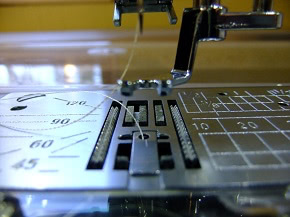
Many quilters make the mistake of assuming that if a machine’s feed dogs can drop (the little teeth below your needle), then that machine will be great for machine quilting. This is unfortunately not always the case, and you should never look at this feature as a sign that the machine has been designed for machine quilting.
Some machines do work better, but many machines react badly when the feed dogs are dropped. If you find yourself struggling with tension issues or bad stitch quality try leaving your feed dogs UP in the normal position, and simply lower the stitch length to 0. You may find your machine works much better and produces far nicer stitches.
Now let’s talk about other features you can look for when shopping for a machine.
It does, generally, help to have a bigger machine with a larger harp space – the space between the needle and the motor. A smaller harp space can be tricky to work around when dealing with a big quilt. It’s not impossible to quilt a big quilt in a 6-inch harp, but it might not be as fun as it could be if you had more room.
Unfortunately you will find as the size of the machine increases, so does the price.
Right now you can find several machines with an 8- to 9-inch harp space from around $700 – $1500. These machines are the Juki TL2010q, the Brother PQ-1500s, and the Babylock Jane (BL500A).
All three of these machines are lockstitch machines, meaning the needle ONLY goes up and down – no zigzag, no fancy stitches, no moving the needle. While this might sound like a limitation, it’s actually a benefit for free motion quilting because this is all you need the machine to do and you won’t be paying for features you don’t need.
I’ve pointed out these three machines because they all come with three awesome features that make them terrific for free motion quilting:
- Stronger motors capable of 1500 stitches per minute – free motion quilting is generally stitched at a slightly faster speed than regular sewing, so this is a very nice feature to have the extra power when you need it.
- Automatic Needle Up / Down – When machine quilting, to rotate or move the quilt, you’ll need to always have the needle in the down position. It’s very helpful to have the machine end with the needle down so you don’t have to constantly rotate the hand wheel before shifting the quilt.
- Knee Lifter – this is a bar you operate with your knee that lifts the presser foot, allowing you to reposition and rotate your quilt without taking your hands off your project.
Keep in mind that you definitely don’t NEED these features to free motion quilt. They are nice to have, certainly, but they’re not required to be able to machine quilt.
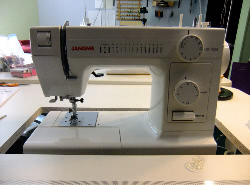
Case in point, is this little Janome HD 1000 sewing machine. This machine costs just $300 and comes with no special features or high speed motor. You’ll need to purchase a low shank darning foot for this machine because it doesn’t come with one as a standard accessory!
But despite those limitations, it really can free motion quilt nicely, as you can see in this video:
Note: this video isn’t specifically featuring the machine, but how to stitch stippling, which might also be something you want to try!
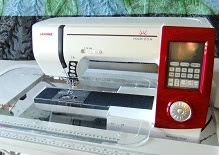
Of course, it would be unfair to finish this post without sharing what machine I personally use for free motion quilting. I quilt on the Janome Horizon 7700, which retails for around $2000 – $3000, so it’s definitely on the expensive side of home sewing machines.
However, it’s far cheaper than any similar table mounted longarm, or similar sized home machine. The Janome Horizon also comes with hundreds of features like decorative stitches, a built in even feed system, and super bright lights.
I love this machine because it produces a beautiful stitch, comes with all the features I mentioned above (knee lifter, needle up/down, strong motor), and has proven itself to be a strong workhorse.
Please note that I do not use the "free motion setting" on the 7700 that is programed to drop the feed dogs. Instead I simply lower the stitch length to 0. This means the feed dogs still move up and down, but they no longer feed the quilt forward or impact your ability to move the quilt in all directions.
As with all big purchases, please take your time in selecting your quilting machine, and if you can, make sure to test drive it to see how the machine stitches in person. Take your time, ask questions, and always be 100% sure you’re satisfied with the machine before purchasing.
Good luck!
Leah Day
Free Motion Project
What will I look for in my next machine?
- Locking stitch.
- A computerized program that allows me to easily set my own ‘most used stitches’ on a panel where I can call them up anytime I like.
- Ability to move the needle position on ANY stitch. Many machine programs that needle position for decorative stitches and I prefer to make that decision myself.
- Large table to go with the machine, or a drop in table.. such a luxury that I should have!
- Ability to lift the presser foot with either a knee lift or with some option on the machine. This is mandatory for a lot of machine applique as it’s your third hand and improves your sewing speed immensely!
Here are some of the major Sewing Machine company sites … and if I missed your favorite… leave the link in the comments!
Want to learn about Featherweights? There’s a nice write up here! I own a ‘white’ one.. in a pretty green case!
Roseann is a regular guest on my radio show. Listen to my radio show… I interviewed Leah on Sept 20 2010… and she will be on the show again very soon!
What features do you want in your next sewing machine?
Pat Sloan is owner and founder of the quilting design and publishing company Pat Sloan & Co. She has published over 25 books, more than 100 patterns, nearly 10 fabric lines, and has had her work featured in all the major Quilt magazines. In January 2010, Pat started hosting her weekly Internet Radio show called Creative Talk Radio.
Find Pat here:
Web Site | Blog | Radio Show | Facebook | Twitter
Quilt Forum | Pinterest | Newsletter


Lots of great information, Ladies,
thanks for sharing.
Wonderful and valuable advice! I’ll bet you ladies have helped a LOT of sewers out there today.
I have a Janome 6600p and absolutely LOVE it. I think it is wise to try many of them out and find what is going to perform best for the type of sewing you want to do.
(I always bring my own fabrics when testing a machine…..often times those shop sample bits are a lot more “stiff” that what we actually sew with)
Great information. I love my Janome Horizon. It has everything I could ever want except for embroidery.
I previously had a Janome 6500 that I really loved but I was ready for a new machine so I went shopping two weeks ago. I really thought I “needed” a Bernina but soon found out that I indeed did not. I went home with a Bernina B820 and could not live with it. Heavy, awkward, too slow, complicated. I took it back and bought a Baby Lock Symphony and I love it! It is super easy to use, light, quiet, powerful, fast, one of the fastest machines out there. It comes with tons of accessories, 17 feet and something like 460 stitches. It has a 8-5/16″ harp which is smaller than I wanted but I can live with it. I love the huge quilting table that comes with it. For $2000 it seems far better and easier to use than the $7000 Bernina. I HAD to have a thread cutting function and a nice table and I wanted at least a 10″ harp. To have those things your only choice of Bernina (which I really thought I wanted) was the expensive and complicated 820. I hated it. I wanted to sit down and sew without a huge learning curve and it is very intuitive and easy to use. I’m very pleased!
Great information!I have a wonderful expensive machine, but LOve my Sears Kenmore sewing machine…it’s sturdy so simple to run! I don’t even know if they’re sold anymore.
I have a Janome 6600 that is fabulous!!! I like the larger harp space for quilting and since my handwork is severely limited by arthritis, I am very pleased with many of the “fancy” stitches that are built in. I even do my binding with them. If you use a varigated thread, you can get some terrific results.
O.K. Here it is. I first owned a Singer. Then a Kenmore. I still have the Kenmore and don’t use it. I used a Pfaff and didn’t like the way it felt. I had my Singer break down and bought my first Bernina 1230 and fell in love! It purred like a kitten, it was easy to change the feet. Easy to change the bobbin, easy to change stitches, back-stitch, etc. It could almost make coffee and serve dinner!!! I then bought my second Bernina QE Aurora 440 and it came with a BSR and again I learned new things. Like I could quilt with the same exact stitch lengths!!! Amazing! And My Bernina 1230 is worth more then when I first bought it! So I guess that makes me a good investor also! Who knew? I was told to try my hand at the slots!
I still sew on my Bernina 1530 I bought 20 years ago and still love it. It does the job fantastically and I see no need to ‘trade up’. I love Berninas! My first machine way back in HS was some cheap piece of you-know-what made in China. Oh how I used to fight with that machine, or I should say it fought with me! It’s a wonder I ever stuck with sewing! Very informative article.
my janome 6600 is like my 3rd child (because technically I got her before I had my last daughter). I sewed on a White before that and when i went to a Quilts by Barb retreat I borrowed my mother-in-law’s Janome to sew on – I called and had mine ordered before i left! And I still LOVE it!
Wow! I didn’t realize how many things there are to keep in mind when you’re looking for a new sewing machine! I started making quilts by borrowing my mom’s old “work horse” Bernina, so when it was time for me to get my own machine, I just got a Bernina, too! Apparently I got lucky because I’ve been using it for the past 15 years and I have no complaints.
Thank you so much for this valuable information. My little Kenmore sewing machine has sputtered its last stitch. I have been waiting to get a new machine for quilting and some clothing sewing. It will have to be $300 or less with a sewing platform or table area I can purchase as well. All this information you provided will certainly help me to find the right machine for me. thank you again.
I am going to be shopping for a new machine shortly and am thinking about buying the Janome Horizon. My first sewing machine was a Singer Touch n Sew which I had for 40 years. Four years ago when I was making so many quilts, I bought a Kenmore machine from Sears for about $250. Kenmore is made by Janome. This little machine has been a real workhorse and I have even quilted large quilts with it so it has worked the $250 worth and more. I will put it into semi retirement and use it for classes when I buy my new Janome Horizon. I am a fan of Leah Day.
During a recent high end serger purchase I was able to secure discounts for: not using credit card (paying with cash or check) 4%, not paying CA sales tax because I was having my purchase shipped to me in another state, subtract cost of tote not needed, they included manuals usually purchased separately and a set of feet. ASK! They just might say yes depending on how badly they want the sale.
Thank you, and all the contributors, for this great round up! I’ve included a link to this post in today’s article!
http://lanettascreations.blogspot.com/2013/09/sewing-machine-features-top-three.html#.Ui7ntcasiSo